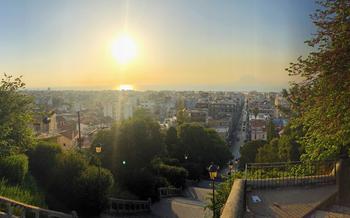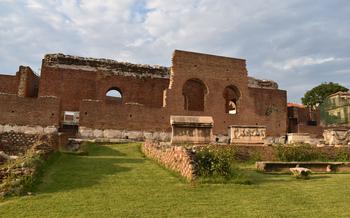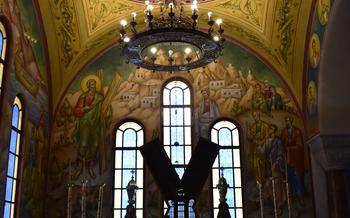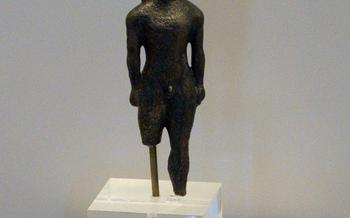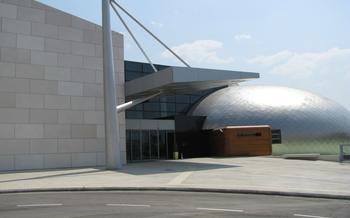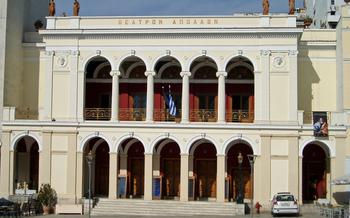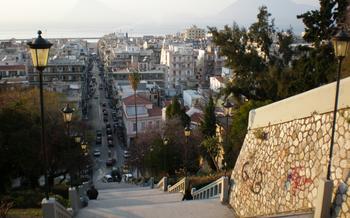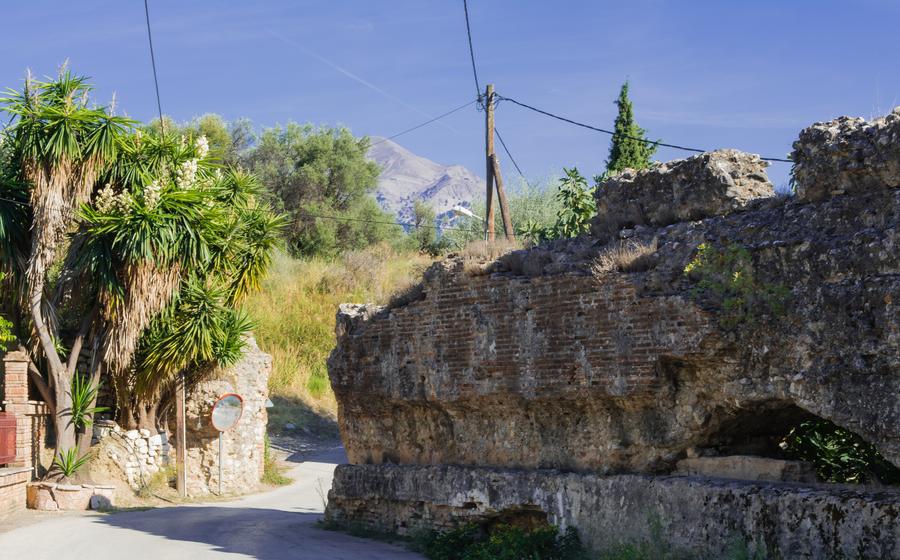
The Roman Aqueduct
- Historical Significance
- Architectural Features
- Location and Accessibility:
- Visiting Hours and Admission
- Guided Tours
- Things to See and Do
- Best Time to Visit
- Photography Opportunities
- Historical Context
- Restoration and Preservation
- Accessibility for Visitors with Disabilities:
- Souvenirs and Local Products
- Insider Tip: A Hidden Perspective
Historical Significance
The Roman Aqueduct of Patras stands as a testament to the engineering prowess and urban planning of the ancient Romans. Constructed during the 1st century AD, this monumental structure was a vital part of the city's infrastructure, supplying fresh water to its inhabitants from distant springs. Its impressive stone arches and intricate details showcase the architectural mastery of the Romans, who left an indelible mark on the city's history. Moreover, the aqueduct played a pivotal role in the development of Patras, transforming it into a thriving commercial and cultural center. Understanding the historical context of Patras during the Roman period and the significance of aqueducts in ancient Roman cities enhances our appreciation of this remarkable engineering marvel.
Architectural Features
The Roman Aqueduct in Patras stands as a testament to the engineering prowess of the ancient Romans. Its impressive stone arches, intricately carved details, and sturdy construction are a sight to behold. The aqueduct's design showcases the Romans' mastery of hydraulic engineering and their ability to create structures that were both functional and aesthetically pleasing.
Admire the massive stone blocks that form the aqueduct's arches, each carefully fitted together without the use of mortar. Observe the intricate carvings that adorn the structure, including decorative moldings, friezes, and inscriptions. These decorative elements add a touch of elegance to the aqueduct, demonstrating the Romans' attention to detail and their appreciation for beauty.
Study the architectural techniques employed in the construction of the aqueduct. The Romans used a combination of gravity and pressure to transport water over long distances. The aqueduct's gentle slope allowed water to flow naturally, while the sturdy arches provided support and stability to the structure.
Appreciate the harmonious blend of functionality and aesthetics in Roman engineering. The Roman Aqueduct in Patras is not only an impressive feat of engineering but also a work of art. Its architectural features showcase the Romans' commitment to creating structures that were both practical and visually appealing, leaving a lasting legacy for future generations to admire.
Location and Accessibility:
The Roman Aqueduct is conveniently located in the heart of Patras, a short walk from the city's main square, Plateia Georgiou I. To reach the aqueduct on foot, simply head west from the square along Agiou Nikolaou Street for about 500 meters. You can also take public transportation, with bus lines 1, 2, and 3 stopping nearby at the "Roman Aqueduct" bus stop. If you're driving, there is limited street parking available in the area, but it's recommended to use a parking garage or lot to avoid any inconvenience. For those using GPS navigation, the exact coordinates of the Roman Aqueduct are 32387° N, 27432° E.
Visiting Hours and Admission
The Roman Aqueduct in Patras is open to the public daily, throughout the year. However, the specific hours may vary depending on the time of year and special events. Generally, the site is open from 8:00 AM to 6:00 PM during the summer months and from 9:00 AM to 5:00 PM during the winter months. Admission to the aqueduct is free of charge, allowing visitors to explore this ancient marvel without any financial barriers. For further inquiries or updates on visiting hours, it is advisable to contact the local tourism office or check the official website of the Patras municipality.
Guided Tours
Guided tours of the Roman Aqueduct are available for visitors who seek a deeper understanding of its history, architecture, and significance. These tours are led by knowledgeable guides who provide insights into the construction techniques, engineering marvels, and historical context of the aqueduct. Visitors can learn about the role it played in supplying water to ancient Patras and its impact on the city's development.
Guided tours typically last for around 30 minutes to an hour and cover various aspects of the aqueduct, including its construction, function, and preservation. Visitors can ask questions and engage in discussions with the guides, allowing for a more interactive and informative experience.
To book a guided tour, visitors can contact the local tourism office or check with tour operators in Patras. Some tours may require advance reservations, especially during peak tourist season. It is advisable to inquire about tour schedules, prices, and availability before planning a visit.
Things to See and Do
The Roman Aqueduct offers a range of attractions for visitors to explore and enjoy. Begin by marveling at the impressive stone arches that stretch across the landscape, a testament to the engineering prowess of the ancient Romans. Admire the intricate details and decorative elements that adorn the structure, showcasing the artistic talents of its builders. Take a leisurely stroll along the aqueduct, appreciating the harmonious blend of functionality and aesthetics that characterizes Roman engineering.
For a more immersive experience, engage in photography and capture the aqueduct's grandeur from various angles. Experiment with different camera settings and techniques to capture the perfect shot, ensuring you have a lasting memory of this remarkable landmark. Share your photos on social media using relevant hashtags to inspire others to visit this hidden gem. Consider using a tripod or drone to capture unique perspectives and breathtaking aerial shots that showcase the aqueduct's scale and majesty.
Explore the surrounding area, where you'll find a wealth of historical and cultural attractions. Visit the nearby Archaeological Museum of Patras to delve deeper into the region's rich past. Stroll through the picturesque streets of the old town, admiring traditional architecture and vibrant street art. Indulge in local delicacies at charming tavernas and cafes, savoring the flavors of traditional Greek cuisine.
Best Time to Visit
Timing is essential when visiting the Roman Aqueduct to ensure an optimal experience. Aim to arrive early in the morning or late in the afternoon to avoid the midday heat, especially during the summer months. These times offer softer, more diffused lighting, which is ideal for photography enthusiasts seeking dramatic shots of the aqueduct against the sky.
Additionally, consider visiting during the spring or fall seasons to enjoy pleasant weather and fewer crowds. The aqueduct takes on a unique charm during these shoulder months, with the surrounding landscape adorned with colorful wildflowers or autumn foliage.
If possible, plan your visit to coincide with sunrise or sunset. These magical hours bathe the aqueduct in a warm, golden glow, creating a picturesque scene that will leave you spellbound. The soft light enhances the textures and details of the stonework, making it a photographer's paradise.
Keep an eye out for special events or festivals that may be held at the aqueduct throughout the year. These events often showcase the rich cultural heritage of Patras and offer a lively atmosphere to complement your visit.
Photography Opportunities
The Roman Aqueduct of Patras presents a remarkable opportunity for photography enthusiasts to capture the grandeur of ancient engineering and architectural beauty. With its imposing stone arches, intricate details, and picturesque surroundings, the aqueduct offers a wealth of photogenic subjects.
To make the most of your photography experience, consider using a tripod to stabilize your camera and capture sharp images. Experiment with different angles and perspectives to showcase the aqueduct's impressive scale and architectural features. The surrounding landscape, with its lush greenery and distant hills, provides a stunning backdrop for your shots.
For truly breathtaking images, plan your visit during sunrise or sunset, when the warm golden light casts a magical glow on the aqueduct. These golden hours offer the perfect lighting conditions to capture the intricate details of the stonework and the dramatic shadows that accentuate the aqueduct's grandeur.
Capture the essence of the aqueduct's historical significance by including people in your shots. Whether it's a lone traveler admiring the structure or a group of friends exploring the site, human elements add a sense of scale and narrative to your photographs.
Share your stunning captures on social media using relevant hashtags to connect with other photography enthusiasts and inspire fellow travelers to explore the wonders of the Roman Aqueduct. Don't forget to tag the location to help others discover this hidden gem in Patras.
Historical Context
During the Roman period, Patras flourished as a significant port city and a strategic hub in the Peloponnese. The construction of the Roman Aqueduct stands as a testament to the city's prosperity and the advanced engineering capabilities of the Roman Empire. The aqueduct played a vital role in supplying water to the growing population and supporting the city's economic activities. It also served as a symbol of Roman power and prestige, reflecting the empire's commitment to infrastructure development and urban planning.
The presence of the Roman Aqueduct and other Roman ruins in Patras offers a glimpse into the city's rich historical heritage. Visitors can explore the well-preserved remains of the Roman Odeon, a theater used for musical performances and public gatherings. The Roman Baths, located near the aqueduct, provide further evidence of the city's once-thriving Roman community. These archaeological sites collectively showcase the enduring legacy of Roman rule in Patras and its profound impact on the region's culture, economy, and infrastructure.
Restoration and Preservation
The Roman Aqueduct in Patras has undergone significant restoration and preservation efforts to ensure its longevity and continued appreciation. Recognizing the importance of protecting this historical landmark, local authorities, organizations, and dedicated individuals have collaborated to safeguard its heritage for future generations.
The restoration process involved meticulous attention to detail, employing traditional techniques and materials to maintain the aqueduct's authenticity. Challenges arose due to the structure's age and exposure to the elements, requiring careful planning and expertise to address these issues while preserving its original character.
Through these efforts, the Roman Aqueduct has been restored to its former glory, allowing visitors to admire its grandeur and appreciate the remarkable engineering achievements of the ancient Romans. Its preservation serves as a testament to the enduring legacy of this iconic landmark and the commitment to protecting Patras' rich cultural heritage.
Accessibility for Visitors with Disabilities:
The Roman Aqueduct is committed to providing an accessible and inclusive experience for visitors with disabilities. The site features designated parking spaces for disabled visitors, ensuring convenient access. Additionally, ramps and elevators have been installed to facilitate movement throughout the site, allowing everyone to explore the aqueduct's wonders without barriers. If needed, visitors can request assistance from friendly and helpful staff, who are always ready to provide support and ensure a seamless visit for all.
Souvenirs and Local Products
To cherish the memories of your visit to the Roman Aqueduct and Patras, consider purchasing souvenirs or local products that reflect the city's rich history and culture. Several shops, markets, and artisans offer unique and authentic items that capture the essence of the region.
Look for traditional Greek handicrafts, such as hand-woven textiles, intricate pottery, or delicate jewelry inspired by ancient motifs. These items make for beautiful keepsakes and are often made by local artisans using traditional techniques passed down through generations.
Don't miss the opportunity to savor the local flavors of Patras by purchasing specialty food products like olives, olive oil, honey, and traditional sweets. These delicacies are not only delicious but also make for excellent gifts for friends and family back home.
By supporting local businesses and artisans, you contribute to preserving the cultural heritage of Patras while taking home a piece of the city's charm to cherish for years to come.
Insider Tip: A Hidden Perspective
For those seeking a unique perspective of the Roman Aqueduct, venture off the main path and discover a hidden gem. Nestled amidst the lush greenery, find a secluded spot that offers a breathtaking panoramic view of the ancient structure. As the sun casts a warm golden glow, the aqueduct's majestic arches and intricate details come alive, creating a picturesque scene. Capture this moment with your camera or simply soak in the tranquility of this hidden paradise. Remember to respect the environment and leave no trace, preserving this special place for future generations to enjoy.

